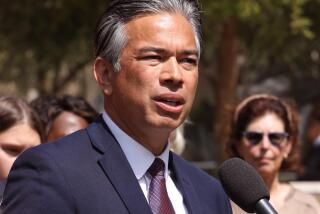City to Study Creation of a Valley Transportation Zone
- Share via
Hoping to improve public transit in the San Fernando Valley, the Los Angeles City Council agreed Tuesday to look into creating a separate Valley transportation zone able to set its own priorities and routes for bus and van service.
The new zone, modeled after one in the San Gabriel Valley, would be virtually independent from the mammoth Metropolitan Transportation Authority, the county’s umbrella transit agency. For years, Valley transit advocates have criticized the MTA for poorly managing its huge budget and neglecting the Valley, home to 150,000 passengers who ride about 60 bus lines.
“[The] MTA is not operating efficiently,” said Councilman Hal Bernson, who is also an MTA board member. “We’re looking at the potential of improving Valley services.”
Under the motion approved by the council, the city Department of Transportation will conduct a monthlong study on whether such a transit zone would be feasible from a staffing and cost perspective. To justify its existence financially, the new zone must be able to cut current costs of operating Valley buses by at least 25%.
Councilman Richard Alarcon, who introduced the motion, said a Valley district could probably achieve that reduction.
In an unusual move, six other council members, whose districts include parts of the Valley, signed Alarcon’s measure--a reflection of the growing dissatisfaction over how the MTA provides bus service in the area.
“If we can demonstrate the 25% savings, it assures that money within the Valley is better administered,” said Councilman Mike Feuer, one of the co-signers.
“If we don’t think the MTA is as efficient as it could be in administering the funds . . . it’s up to us” to find a better way, Feuer said before the council approved the motion 13 to 1.
The lone dissenter, Councilman Nate Holden, called the idea a “turkey” that would create a superfluous agency. “Once again we’re reinventing the wheel,” said Holden, adding that he objected to special treatment for the Valley.
But Feuer and others said the same type of arrangement could be set up in other parts of the city--such as the Westside and Central City--if the Valley district proved successful.
Indeed, the Valley zone would follow the lead of one already established in the San Gabriel Valley. The Foothill District was created several years ago after a coalition of San Gabriel Valley cities sued the Rapid Transit District for the right to run their own bus service, which the RTD tried to block.
Like the Foothill District, the Valley transportation zone would be a public entity, overseen by a board composed of community representatives and possibly some elected officials. Also like the Foothill District, Los Angeles would need approval from the MTA, which took over the RTD, to establish the Valley zone.
Jim de la Loza, the MTA’s executive officer for regional planning, said his agency will cooperate with the city transportation department studying the zone option.
“The analysis has to be a complete analysis,” including “the overall benefits to the Valley and to the region,” De la Loza said.
But he added: “Our goals are the same here, to improve service in the Valley, and whatever form it takes, we’ll support it.”
More to Read
Sign up for Essential California
The most important California stories and recommendations in your inbox every morning.
You may occasionally receive promotional content from the Los Angeles Times.











